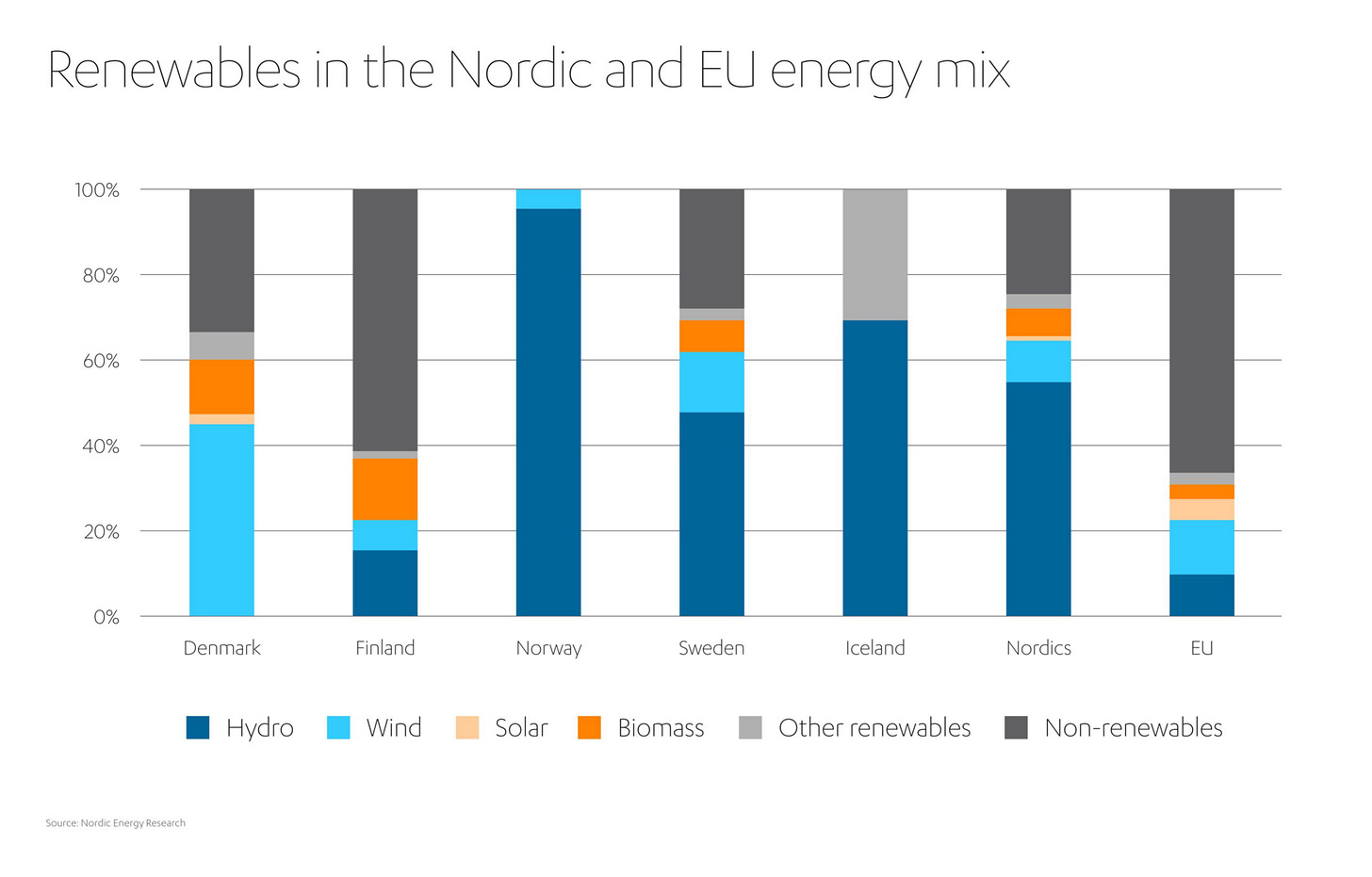The Nordic Way
This article is part of my series on "The Next Economy: Business, Energy & Sustainability in Transition"
In a world backsliding on climate action and sustainability, what can we really learn from the Nordics?
In May 2025, I will be leading a delegation of over 20 Duke MBA students to Denmark and Norway for a 12-day immersion in Nordic sustainability strategy and practice. This is the second year I have offered this course and I was thrilled by the powerful talks and corporate visits, cultural experiences, and transformative learning opportunities we experienced last year. This year, we are approaching this experience with a different mindset. 2025 has been a brutal year for the sustainability field, with dramatic policy reversals and aggressive pushback on climate action and sustainability in the United States. Nevertheless, it seems even more urgent to look toward the leadership and best practices – as well as the challenges – of the Nordic leaders.
This memo provides an overview of the climate, energy, and sustainability strategies in Denmark and Norway, highlighting concrete innovations, systemic tensions, and the key takeaways for U.S. policy and practice. Below, I summarize seven themes where Nordic experience can inform our strategy and practice.
Image 1: A view of Equinor's LNG facility in Melkoeya, outside Hammerfest, Norway January 31, 2023. Ole Berg-Rusten/NTB via REUTERS
I. Policy Frameworks
1. Creating Integrated Policy Frameworks: Long-Term Vision and Cross-Sectoral Coordination
Both Denmark and Norway have anchored their sustainability ambitions in clear national legislation. Denmark's Climate Act (2020) legally mandates a 70% emissions reduction by 2030 compared to 1990 levels, with binding five-year targets and independent oversight. Norway, under its 2017 Climate Act, targets carbon neutrality by 2050 and aligns sectoral planning—in transport, industry, and land use—with this goal. Denmark's Ministry of Climate, Energy and Utilities collaborates closely with other ministries to align green transition plans across energy, housing, and industrial policy. The country also embeds climate goals into its national budgeting process. In Norway, the Ministry of Climate and Environment integrates climate targets into long-term infrastructure plans, including the National Transport Plan.
Takeaway for MBAs: Long-term planning backed by legislation, paired with cross-ministerial coordination, can create consistency for business and public sector investment alike. Consider: How might businesses advocate for such policy integration, and what are the potential ROI implications? While this may seem like a remote possibility at the U.S. federal level currently, it is important to highlight the role of policy integration at the state and local levels now – and the need to establish long-term policy stability for the country over the long term.
2. Setting Carbon Pricing and Economic Signals
Both Denmark and Norway have deployed carbon pricing mechanisms alongside regulatory and innovation policies. Norway combines participation in the EU Emissions Trading Scheme (ETS) with a rising national carbon tax that will exceed 200 EUR/ton by 2030. Denmark's 2022 carbon tax reform expands pricing to agriculture and heavy industry, including methane from livestock—a bold move in a region dominated by meat and dairy production. Importantly, these revenues are not siloed. They are recycled into green investments, social protection, and competitiveness support for affected industries.
Takeaway for MBAs: Effective carbon pricing can coexist with economic growth, but public trust and transparent revenue use are essential for political durability. How do these pricing mechanisms create both cost pressures and innovation incentives for businesses?
II. Energy Transition
3. Managing Energy Transition: Wind, Hydro, and Emerging Technologies
Exhibit 1: Nordic countries’ energy mix
Denmark is a global pioneer in wind energy, with wind providing over 50% of its electricity. The Danish government's Energy Islands initiative—involving the construction of massive artificial platforms in the North and Baltic Seas to host offshore wind farms—represents one of the most ambitious renewable infrastructure projects in the world. These islands will also serve as hubs for green hydrogen production and international power export. Norway, by contrast, already enjoys a nearly 100% renewable electricity grid, dominated by hydropower - yet it is simultaneously Europe’s largest oil and gas producer. This paradox defines Norway's climate policy: it invests heavily in carbon capture and storage (CCS), green shipping, and offshore wind, while relying on oil revenues to fund its sovereign wealth fund and green transition investments.
Takeaway for MBAs: While each country's energy mix differs, the importance of investing in enabling infrastructure (e.g., transmission, storage, interconnection) and diversifying clean energy pathways is broadly applicable. How can businesses navigate the risks and opportunities created by these differing energy transition strategies?
III. Urban & Innovation Ecosystems
4. Urban Climate Leadership: Copenhagen and Oslo
The cities of Copenhagen and Oslo are global exemplars of urban climate governance. Copenhagen aims to be the first carbon-neutral capital by 2025, combining energy-efficient district heating, electrified public transport, and sponge city infrastructure to manage stormwater and urban heat. The city integrates climate targets into urban design, public procurement, and citizen engagement. Oslo, similarly, has pioneered the use of a climate budget—a financial-style accounting tool that tracks greenhouse gas emissions by sector and links emissions cuts to city agency performance. Oslo has electrified its entire bus fleet, banned fossil-fueled construction equipment on public projects, and invested heavily in walkability and public space.
Takeaway for MBAs: Empowered cities, with autonomy and budgetary tools, can be catalysts for national climate ambition. What are the business opportunities in providing solutions for urban climate adaptation and mitigation?
5. Public-Private Innovation Ecosystems
Nordic governments actively co-invest in climate innovation. Denmark's GreenLab and Energy Cluster Denmark support cross-sector experimentation in power-to-X technologies, green fuels, and circular manufacturing. Norway's Enova fund helps scale zero-emission transport, green buildings, and heavy industry decarbonization. One standout initiative is HYBRIT in Sweden (with implications for Norway), where SSAB, LKAB, and Vattenfall are developing fossil-free steel using green hydrogen. Though not headquartered in Denmark or Norway, the project reflects the regional innovation ecosystem supported by Nordic policy frameworks.
Takeaway for MBAs: Climate innovation thrives with government co-funding, clear market signals, and collaborative platforms that reduce risk for early adopters. How can businesses effectively partner with governments to drive innovation in the cleantech sector?
IV. Societal Foundations
6. Navigating Internal Tensions in Sustainability Efforts
A central theme of our exploration is "Nordic Dreams, Nordic Dilemmas." Denmark and Norway enjoy a strong global reputation for sustainability leadership, with deep commitments to renewable energy and circular economy. Yet, this image is complicated by significant tensions. Norway, for example, remains a leading exporter of oil and gas, even as it aggressively decarbonizes its domestic energy sector. How do we reconcile these contradictions, and what are the implications for a just transition?
In our preparatory classes, we had a fascinating discussion about Norway’s sovereign wealth fund, the largest in the world – and how Norway’s prosperity has largely derived from their skillful management of resource wealth over the last 35 years. One expected insight emerged in the conversation, as the students of African origin reflected on their experiences of resource management in their home countries. They noted that the potential role of sovereign wealth funds was not well-understood when countries like Nigeria first discovered oil, and they struggled to convert that wealth into widespread prosperity for the country. We also discussed if it would still be possible to adapt some of Norway’s approaches to the Nigerian economy and society.
Takeaway for MBAs: Hands-on experience in the Nordic countries offers a rich laboratory for learning—not because it is perfect, but because the unique experiences of climate action and sustainable practice in the region offer a valuable comparative lens for assessing the possibilities and barriers in our own context. For countries and companies, is it possible to create win/wins, in which actions become more profitable and more sustainable?
7. Social Trust, Equity, and Just Transition
What binds the Nordic approach together is a high-trust, high-equity social contract. Citizens trust that climate policy will be implemented fairly, with attention to geographic, economic, and generational equity. In Denmark, public housing retrofits and energy efficiency programs prioritize vulnerable households. Norway channels oil wealth into a sovereign wealth fund that finances sustainability abroad and buffers domestic transitions. Both countries see climate action as a moral and social responsibility, not just an economic opportunity. This enables ambitious, sometimes uncomfortable policy choices—like removing parking in city centers or phasing out combustion vehicles—with relatively little political backlash.
Takeaway for MBAs: Equity and trust are not side issues. They are foundational to successful climate transition. What lessons can businesses draw from this about stakeholder engagement and social license to operate?
Conclusion: The Nordic Way as Compass, Not Template
Denmark and Norway offer different but complementary visions of a sustainable future. Denmark shows what a small, design-focused, export-oriented nation can do with policy consistency and cross-sector innovation. Norway illustrates how a resource-rich economy can reinvest in its future, even while facing deep contradictions.
For American policymakers and business leaders, the Nordic experience is not a blueprint to copy, but a compass for navigating complexity. During our upcoming trip, we will observe not just the technologies and infrastructure, but the governance models, partnerships, and values that make them possible. We will ask how long-term trust, investment, and institutional alignment can be built at home—and what it would take to move from ambition to action in the U.S. context.
The Nordic Way is not without its trade-offs. But it remains among the most hopeful, pragmatic, and disciplined responses to the climate challenge available today.
There couldn’t be a better moment for grounded inspiration.




Honestly, reading this just reminded me how much of our climate policy here in the US is stuck in constant reset mode. The Nordics aren’t perfect, but at least they pick a direction and stick with it. They pass laws, set clear goals, and follow through across different departments. We can’t even get a consistent energy policy between states.
Also, carbon pricing? They’ve had it for years. Here, we’re still arguing over whether it’s “too political” while ignoring the fact that it works. I’m not saying we need to copy everything they do, but there’s a lot we could learn if we’d stop treating climate as a culture war and start treating it like infrastructure.
It’s not about being more advanced,it’s about being more consistent.